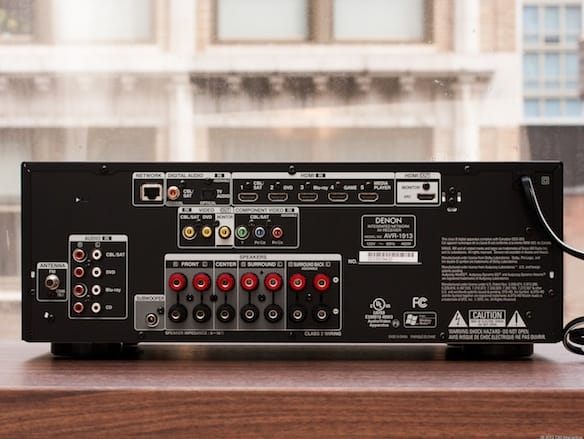
Image credit: Cnet.
Your AV Wallet: A Guide to Home Theater Receivers
You have many AV devices sitting around: your stereo system, iPod, television, Wii, BluRay, etc. These are your assets, just like the ID and money in your wallet. In order to connect those assets so that each one is ready-to-hand at all times, you need an AV receiver, also known as a home theater receiver or surround sound receiver. This is your audiovisual wallet that will keep track of all of your AV assets, each of which constitutes a “channel.” The receiver’s pre-amp allows you to switch between channels.
What are Dolby and THX?
Dolby and THX provide different modes of audio presentation. Dolby technologies encode the sound so that it can be stored more efficiently, and THX provides several listening options and enhancements to sound in post-processing. In other words, it does not modify the work that Dolby does.
What is the difference between Dolby 5.1, 6.1, 7.1, etc.?
Dolby 5.1 has existed for many years, and provides five discrete channels to create a surround sound environment, plus a subwoofer channel. 6.1 adds a matrixed channel to the mix, and 7.1 provides 7 discrete channels plus the subwoofer.
What am I looking for in a good receiver?
Your receiver should be able to handle the quality of all of your A/V assets. For example, if you have a Dolby 7.1 system, make sure your receiver is designed for that. If your TV is HDMI-compatible, your receiver must be as well, etc.
The most important performance qualities are:
SNR (Signal-to-Noise-Ratio): 100 is a high SNR, and a few models go higher
THD (Total Harmonic Distortion): this measures the possibility of electronic interference in your sound, so you want it to be very low, like .05%
Frequency response: the more frequencies in your ear the better, so you want a wide range in this category, at least 10Hz-100KHz (I prefer 5Hz low-range, because I love the bassy tunes)
Power Systems
There are many key features that differentiate different systems in terms of power and inputs. If you hear that something is a “75 watt model,” that means that 75 watts of power are allocated to each channel. The increase in watt output is logarithmically related to decibel output.
Power consumption, on the other hand, is a larger figure pertaining to the amount of power used by the receiver. These figures range from around 100W to more than 600W. The lower-consumption receivers are not necessarily weaker than others.
Recommendations
Denon is known for its high quality and excellent design, and Onkyo, Pioneer, and Sony are other reputable names in the market. If budget is a consideration, look for “step-down” models, which are cheaper and often not a step down at all.
The more time you spend on researching equipment and design, the better your experience will be. Remember: equipment is no more important than design, which includes your furniture, your choice of location, and the arrangement of all of your A/V assets. Some audio/videophiles study Feng Shui to understand the pathways of energy in their home theaters.



